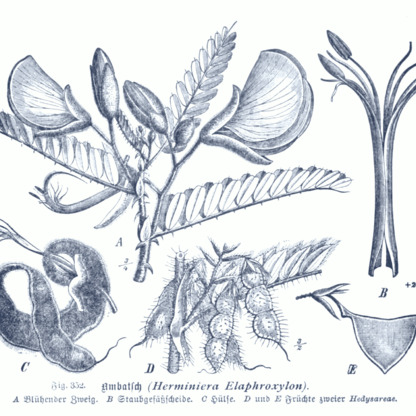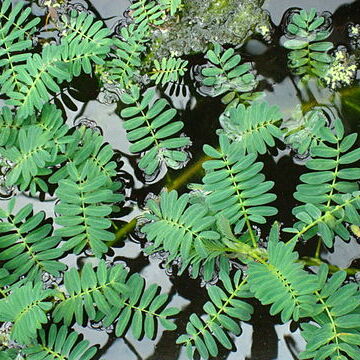alternate, subimparipinnate, 1-10 cm long; leaflets 5-80, alternate or subopposite, subsessile, 2-40 mm long, 1-20 mm wide, glabrous to sericeous, often minutely glandular-punctate, 1-several costate; petioles 2-40 mm long; stipules peltate, appendiculate below the point of attachment or attached at the base and not appendiculate, membranous or foliaceous, persistent or caducous. Inflores-cences racemose, paniculate, fasciculate, or rarely solitary, axillary or terminal, bracteate, bractlets paired and subtending calyxes, pedicels glabrous to pubes-cent, usually glandular. Flowers 5-15 mm long; calyx bilabiate to campanulate, commonly persistent; corolla yellowish to red or purple, petals usually clawed; stamens 10, essentially diadelphous, 5:5, filaments united into a sheath, open on carinal side, and with splitting on vexillar side delayed or merely incipient; anthers dorsifixed, or occasionally basifixed; pollen ellipsoidal, tricolpate; ovary 2-18 ovulate, rarely 1-ovulate, sessile or short stipitate; style incurved, not bearded; stigma terminal. Fruit a loment, (1-)2-18-articulate, subsessile to long stipitate, laterally compressed, occasionally torulose; seeds reniform, smooth, sublustrous, light brown to black, hilum circular, embryo axile, slightly bent, endosperm pres-ent, cotyledons fleshy. Chromosomes: n = 10.
Herbs or shrublets. Vegetative and reproductive parts covered usually with viscid tubercular-based trichomes. Stems erect or creeping, often hollow. Stipules spurred below point of insertion, peltate or unilaterally auriculate, caducous. Leaves paripinnate, 20-to many foliolate, often sensitive; leaflets opposite, subsessile, with 1 midvein or 2 to several primary veins. Inflorescences usually axillary, usually racemose, with several flowers; bracts paired, stipule-shaped, not spurred, persistent or caducous, margin denticulate. Flower small to medium-sized. Bracteoles present. Hypanthium short. Calyx membranous, usually 2-lipped, abaxial lip 3-lobed, adaxial lip 2-lobed. Corolla usually yellow; standard orbicular, large; wings without an auricle; keels curved, with a small beak. Stamens diadelphous (5+5) or basally connate; anthers uniform. Ovary linear, with numerous ovules; style filiform, inflexed; stigma terminal. Legume a loment, compressed, stipitate, divided into 4-8 articles, surface often muricate. Seed 1 per article.
Cal deeply bilabiate, the tube short, the 2 lips divergent, foliaceous, shallowly lobed; pet subequal, clawed; standard suborbicular to ovate; wings narrowly obovate; keel boat-shaped, obtuse; stamens diadelphous, the filament-tube cleft above and below into 2 groups of 5 stamens each; fr stipitate, elongate, indehiscent, transversely segmented and eventually separating into reticulately veined, 1-seeded joints, herbs (in the tropics shrubs) with pinnately compound lvs and mostly yellow fls in axillary racemes. 150, mostly warm reg.
Fruit linear or elliptic, compressed, straight, slightly curved or in one case rolled into a spiral, shortly to distinctly stipitate, mostly exserted from the calyx, the sutural nerve entire, crenulate, 1–28-jointed; articles disarticulating, round, elliptic or rectangular, flat or slightly convex, smooth or tuberculate, sometimes papery, nearly always indehiscent.
Standard mostly rounded or pandurate, often emarginate, shortly clawed, often with thickenings at the base of the limb and tiny appendages at the base of the claw; wings straight or falcate, oblong or obovate with lateral spur and a series of small pockets; keel petals either partly joined or adhering only by means of the marginal fimbriations when present.
Leaves alternate or subfasciculate on short lateral branches, paripinnately 2–many-foliolate (one species is aphyllous, and one Brazilian species is unifoliolate); stipules truncate or produced below the point of attachment, membranous to leaf-like in texture, persistent or deciduous; stipels absent.
Inflorescences axillary or less often terminal or leaf-opposed, falsely racemose or paniculate, rarely umbellate, or sometimes flowers solitary to ternate or in fascicles; bracts entire or 2–3-fid, persistent or deciduous, rarely wanting; bracteoles inserted below the calyx, mostly deciduous.
Stamens monadelphous or rarely diadelphous, sometimes in 2 joined groups of 5 or the vexillary filament free in a few species; anthers uniform (see below).
Calyx either 2-lipped, the lips practically free, the upper lip entire or 2-fid, the lower entire or 3-fid, or campanulate with subequal lobes.
Erect or prostrate shrubs, subshrubs or annual or perennial herbs or in very few cases climbers, mostly covered with tubercular-based hairs.
Seeds oblong, reniform or lunate, sometimes slightly beaked; hilum small, often eccentric; rim-aril not developed or rarely slightly so.
Ovary linear, usually stipitate, 2–28-ovuled; style inflexed, mostly glabrous; stigma terminal.
Herbs, shrubs, or small trees; stems terete, finely striate, unarmed. Leaves
Flowers small to fairly large, mostly yellow, often lined with purple.


